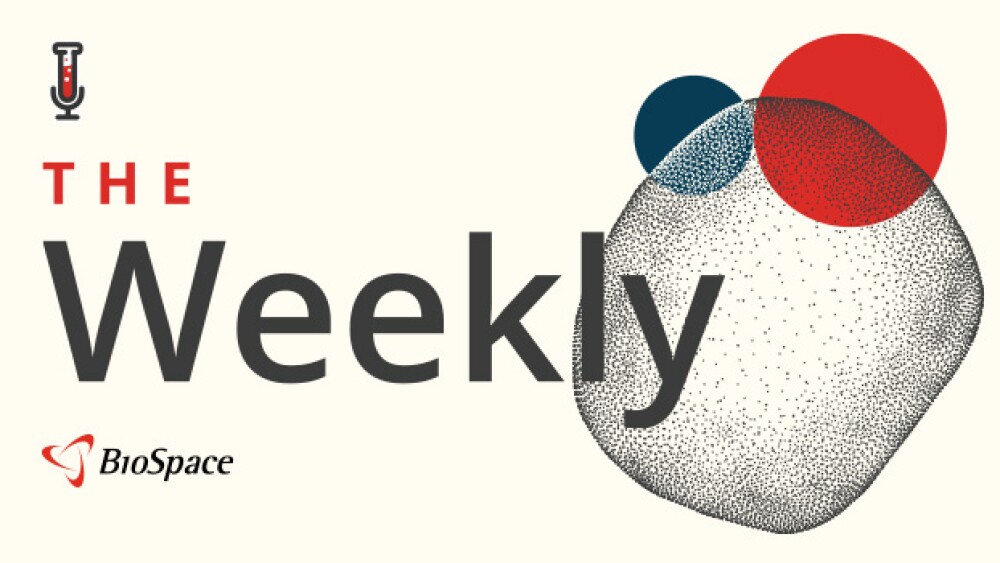By John B. Washington
Amidst the ruck and glitz of “Pop Genetics,” there stand few scientists invested less in the flash or dollars of selling an idea, and more in the often overlooked concept of practical application. The quest for science in the service of the people may seem like a quaint idea nowadays, but, in the end, all quests reflect back upon the needs that predicate them, the human condition. As the understanding of the universe is diving deeper and deeper into the dark infinitesimal world of the nanometer, springing back out into the full-sized dimensions are fantastic tales of undentable fenders, paper-thin televisions, omnipotent fabrics, unsliceable golfballs, cures for cancer, cures for HIV, cures for this, cures for that, et cetera, et cetera, gene therapy, et cetera. But the pants that I wear are still mortal, and there is a woman in Denver with a five-month-old boy, a twenty-month-old girl, a husband, a mother, a father, a brother, and an “incurable” disease, pancreatic cancer. She was diagnosed two weeks ago. She went to the doctor for back pains. She came home with two months to live. Suddenly I forget about my golf ball.
The cancer started in the pancreas, metastasized, dropped anchor in the liver, found its way into the lymph nodes, spread into the heart tissue, even escaped from the organs and started forcing its way between everything, into the belly, gnawing, spreading, doubling, usurping blood supplies, choking vital organs and arteries and growing, always growing. Chemotherapy might kill a piece, here and there, of one or two of the twenty distinct tumors. Radiation might be able to sting another nodule. Surgery wouldn’t dare. It’s all too little too late. Conventional cancer therapy (three archaic options: cut, burn or poison) has its hands tied. Its reach is short, its visibility dim, and its repercussions negligible. There isn’t a survival rate for pancreatic cancer.
The Medical Pathos
“Compassionate Use” is an FDA term for “there’s no hope,” or “there is no alternative treatment.” When a budding biotechnology company has a promising experimental treatment, when a patient is holding life by a tenuous thread, then the patient and the treatment are wed in terms of “Compassionate Use.” The woman from Denver may qualify, but the red tape and the yellow rope and political ramifications and pusillanimous doctors and another month is gone and by then the cancer’s stronghold will be far too impenetrable and again, it’s all too little too late. The FDA is an institution founded on establishing safety before efficacy of a drug. And these caveats, though stringent for good intention, do nothing to let this woman hear her son’s first words, let alone let the boy retain even a single memory of his mother.
The gauntlet of politics and entangling safety standards that a new medicine must survive is long, narrow, and unforgiving. Yet, Epeius Biotechnologies, out of Monrovia, CA, has invented, developed, funded and deployed Rexin-G, a drug adroit enough to survive all the blows and cuffs of the antiquated gauntlet. The next feat is to overcome the dominion of pharmaceutical corporationism and let the new drug do its work. Dr. Frederick L. Hall, inventor and founder, and Dr. Erlinda Maria Gordon, co-founder, have had to go to the other side of the world to find a gap in the barbed wire fence that surrounds American corporate medicine. The sign on the fence reads, simply, “No Trespassing,” and the guard dogs on the other side pay no heed to purity of intention. Top-echelon drug moguls (the “mobsters of medicine”) have their lots staked, and frankly, there’s no room for anybody else. Nevertheless, after much sweat and ingenuity, five patients suffering from pancreatic cancer found a doctor with some pluck, found their ways to the Philippines, and were finally infused with the world’s first targeted viral treatment, Rexin-G. Though the doses were only for establishment of safety, all five patients showed marked and never before seen improvements, and without any debilitating side effects.
The Clinical Need
Genetic Engineering is no new concept. Sequencing genes is now as easy as ordering pizza, just ring over to one of the myriad bubbling biotech companies in north county San Diego and a few days later you’ll get an email full of G’s, T’s, A’s, C’s all mix-mashed and spelling out cellular blueprints. Unfortunately, cloning and sequencing by themselves, though exciting (remember all the Dolly hoopla, or the “oh-so-riveting” hunt for the human genome), are to no avail. In concept and in vitro (in cell-culture dishes), we can proselytize and high-five all we want, but it is to no avail unless we find some method of clinical application. It’s like wielding a sword without swinging. Until all the therapeutic hype is embraced and expressed by our living cells, inside of our bodies, “Pop Genetics” is as meaningful to cell-cycles as the gossip page. Until an effective gene-targeted system is developed, it is all wordplay, a sort of “nano-fiction.” Imagine Freud or Mozart never picking up a pen and you might be able to understand the trifling repercussions that genetic scrambling will have if it is never published, never read by the cell: all the genius is to zero gain. We have all the concepts of genetics and genomics and we’ve man-handled and “perfected” the genes, but we’re still sorely lacking the basic transportation. All of our “messianic” genetic permutations have been revving in idle, talking all the talk, but still hiding in the garage. That is, until now.
The Enabling Technology
Rexin-G, the principle gene delivery vector (the “medicine courier”) of Epeius Biotechnologies, complete with guidance system and “cell-abort” commands, is made from an unprecedented array of eclectic components: utilizing a conglomerate of viral, bacterial, bovine, murine, human and fusion proteins. Though not particularly appetizing, this manifold construct is looked upon as the veritable “Holy Grail” of gene delivery. It is the first ever “pathotropic” (disease seeking) vector in the world, designed like a heat-seeking missile, to deliver cytocidal (self-destruct) signals to diseased cells. Rexin-G functions in much the same way as the body’s own platelet guidance system works. It’s targeting technology is adapted from the Von Willebrand factor, which lets the platelets attach only to collagenous lesions, and is applied to function as a regular patron within the human circulatory system. In the patient, where cancer has created an injury or fracas of any sort to healthy tissue, collagen is exposed and Rexin-G, streaming about in the bloodstream in sharp pursuit, rapidly congregates around the disturbance, adheres to the collagen, and delivers the elixir.
The Worst Case Scenario
Pancreatic cancer, though called the “silent disease” because symptoms aren’t often felt until months after it has been a-thrive in a body, doesn’t keep “quiet” for long. It strikes and spreads like wildfire, but tip-toeing, at first, not revealing itself until it has so thoroughly infiltrated your system that there is no hope for recovery, nor even detainment. Then the bomb is set off, the canker infantry deployed, discretion is forgotten and the brutality is felt as healthy cells are ravaged, organs are hacked through and blood supplies are despoiled. In response to the inner mayhem, the body panics and sends in the wound healing systems, desperately trying to repair and build walls of connective tissue to halt the proliferation of the cancer. But the disease cannot be contained. The walls of tissue are battered, the buttresses of sinews are destroyed, the attempts at repair are to no avail. The disease is just too strong. The metastatic spread is relentless.
It is in this context that Rexin-G, born of our innate tendency to mimic the fabric of nature in its most extraordinary technologies, begins to shine. Deployed by intravenous infusions, Rexin-G, with its targeted genetic payload, joins the body’s battle. As our own system tries to stifle the inevitable spread of the cancer cells, Rexin-G circulates through the heart and the lungs and then into every other nook and fold as it seeks out and accumulates selectively in the diseased tissue.
Descending another level into intricate molecular chemistry, Dr. Hall, in the early ’90’s, exploiting previous discoveries, recognized that the magnetic attraction (i.e. the guidance system) for our natural coagulating and wound-healing platelets is none other than collagen itself. The crux, as stated by Dr. Hall, is that, “Nature abhors exposed collagen.” And this collagen is only exposed to the blood at severely damaged sites within our bodies (damage resulting from injury: from something as harmless as a cut, to which your platelets will race to clot the leakage, to something as fatal and ruthless as metastatic cancer). Basically, Dr. Hall engineered a sort of “key,” a functional domain on the cloaked envelope of the vector that will only attach, like the platelets, to exposed collagen. Thus the world’s first “heat-seeking,” tumor-busting, targeted-vector-system was developed by resourcefully adaptive engineering. Amazingly, Epeius Biotechnology’s TDS (targeted deliver system), the elixir of cancer therapy, the “holy grail” of genetic medicine, was elucidated in the understanding of something as inert as straw (collagen) and as exciting as a scab.
The Historic Flashback
Though the most innovative and ingenious aspect of Rexin-G is the physiological surveillance function embodied in the targeting system, though the vector has arrived at the battlefield, the cancer still needs to be killed. If only showing up to the battle were enough… cancer would be a tragedy of the past. But mere presence is not enough to frighten away disease. Now that Rexin-G has valiantly found and infiltrated the cancerous lesion, like the Trojan Horse finagling its way into Troy, it must still devise a way to stop the cancer cells from continuing to divide. Remarkably, the namesake of Epeius Biotechnologies is a similarly shrewd architect/engineer. Epeius the man, as sung by Homer, originally conceived and designed the Trojan horse. And as the story goes, Epeius, after all noble and heroic efforts had failed, was the only man able infiltrate a city that had withstood, for years, incessant bombardment. But his innovative architecture itself wasn’t enough to destroy Troy, remember, the Trojan Horse didn’t have teeth, it wasn’t built to thrash and stomp the city to death, it was that which was concealed within the Trojan Horse, Odysseus and his comrades, that actually won the battle.
Modern day Epeius (the biotech company) took this ingenious cunning to a new level with the development of Rexin-G. Instead of delivering to the cells a bomb, or an ax-wielding soldier, it drops off a snippet of malicious code. In his studies of the molecular genetics of growth control, Dr. Hall recognized that an essential driver for dividing cancer cells is a gene, named alphabetically by the order of discovery, Cyclin-G (the term cyclin refers to its role in governing the cell cycle). To remove or block this gene would inexorably halt cell division, thus derailing cancer’s progression. Dr. Hall then created a mutant Cyclin-G, a cell killing designer gene. This altered gene uses the principle of the “dominant negative” replacing Cyclin-G with an impostor, a gene that occupies the throne, but won’t let the cell divide. Like snapping a key off in the ignition of the cell, the impostor Cyclin-G blocks any possibility of progression or division and the ambushed cancer cell, realizing its impotency, surrenders itself to apoptosis (cell suicide)…. and dies.
The Therapeutic Gist
As the maxim goes, the best defense is good offense. And a good offense is exactly what Rexin-G provides for the cancer-stricken body. The targeted vector, smartly cloaked in a lipo-protein envelope, sallies about the blood vessels until it finds a cell or group of cells that are growing abnormally fast (therefore expressing the requisite Cyclin-G) and disrupting normal tissues. Then, under the guise of a gift, the vector attaches to the outside of the cell, whose “doors” ignorantly open to its own demise, and once inside the cell, the vector releases the impostor Cyclin-G gene which takes the place of the divide-commanding gene, the original Cyclin-G. As the cell cannot divide, the key is metaphorically snapped off in the ignition of the cell cycle machinery, and the cancer cell aborts all plans, as does its attendant blood supply, and, abjectly, kills itself. In essence, Rexin-G provides a true “seek and destroy” offence for the critical cancer patient, as well as a benevolent surveillance function which serves as a sort of “neighborhood watch” for other larcenous cancer cells.
The Profundity
By targeting diseased tissues and selectively killing deviant cells, the system minimizes collateral damage to healthy tissues and major organs. The strategic design of the genetic payload, and the accuracy of the guiding system, make it exceedingly unlikely for Rexin-G to damage healthy cells and thus, only the cancer cells and tumor vasculature of the body will die with each infusion. The side effects of this treatment are as negligible as the results of chemotherapy: no systemic toxicity, no liver or kidney dysfunction, no bone marrow suppression, no vomiting and no hair loss, all of which the patient must concede to while undergoing the orthodox cancer treatments of chemo or radiation. The worst response a patient has yet exhibited was a slight and ephemeral skin rash. Not a bad deal: goosebumps in lieu of cancer. Every patient enjoyed a reduction of tumor burden and a blessed extension of life. Rexin-G is the most accurate medicine in the world, leaving all healthy tissue untouched and unharmed. It is the William Tell of cancer treatments. It doesn’t miss.
The Corporate Conundrum
The development of Rexin-G, the advent of a Targeted Delivery System (TDS), and the clean demonstration of clinical effectiveness are not the only unique credits to Epeius Biotechnologies. The typical battle strategies of the pharmaceutical giants entail diehard glitz, promotion and hyped-up promises. The companies attract investors, hawk their stories, accrue millions, and conceptualize until they’re blue in the face. The clinical applicability and therapeutic potentiality behind each of their wily marketing strategies remain, for years, mere projections. Despite all of their state-of-the-art-ness, or cutting-edge-ness, the deeply invested promises manifest into little but equivocal excuses and evasion. Money, as proven over and over again, cannot buy scientific achievement. Innovation, as proven by feeble-minded pharmaceutical giants, cannot be indentured.
Fortunately, Epeius is the pharmaceutical rara avis. The company has developed an unique agenda: the foremost priority being service to the individual patient. Batches of Rexin-G are manufactured, honed, and improved according to actual demand. And the demand is great. Every year thirty-thousand people in America are diagnosed with pancreatic cancer. And every year thirty-thousand people in America die of pancreatic cancer. It is these hard facts on which Epeius Biotechnologies sets its focus: the utility of the treatment and the health of the patient. Unfortunately, ingenuity and effectiveness themselves are not strong enough to deliver the drug. Marketing and money are critical to the lives of cancer patients, to deliver the medicine. This leaves the small fish in the pharmaceutical pond at a frightening disadvantage, without the money to support clinical trials, or to prove statistical effectiveness, there can be no marketing strategy, and the patients, yet again, are left high, dry, and dying of pancreatic cancer.
In the past year, Dr. Hall, inventor, designer, manufacturer, and co-owner, has striven relentlessly to purify and fortify the vector, trying, by all available means, to finally bring the medical treatment and this striking technology to the world. Increased levels of potency and accuracy are continuously realized, and now, one bag of the vector infused into the patient takes the place of the previous five. As Epeius and its dedicated scientists continually drive the vector to its very limits, the clout and potential of the treatment see no meager end: the goal is none other than the complete and utter eradication of Cancer itself.
The Good Doctor
Outside of the lab, the co-founder, Dr. Gordon, pushes the drug ever closer to commercialization. New clinical trials are to begin in three cities (Manila, Minnesota, New York), a pilot GMP manufacturing facility is in the planning stages, and the FDA granted Rexin-G orphan drug approval. All of this was accomplished by the critical demand from society, driving the science and the scientists to their full potentiality. Dr. Gordon, inundated with prayers and emails of the cancer-stricken, has pushed the drug forward to the world at unprecedented speeds, accomplishing in only two years (from the first human trial in Manila in 2003 to the full-scale trials scheduled to begin in three cities) what is usually unachieved after a decade of wheel-spinning. She is answering prayers with pragmatism.
But cancer is still killing everyday. And everyday patients are wallowing in the wake of poisonous and incompetent treatments. Rexin-G, though more promising than any cancer drug to date, must still hack through a jungle of corruption and innumerable tests before it can be overarchingly applied. In this striving for application, Epeius has managed to muster private funds, strong-arm the FDA for initial approvals, convince doctors and hospitals to leave the path of cowardly convention, and even find patients that will not settle for the slight, painful, futile, conventional resistance to this disease. But the public at large has remained wholly uninformed of the progress of Rexin-G and the subsequent waning grasp that Cancer has on our lives. In the increasingly toxic environment in which we live, such negligence in support of grass-root cancer initiatives is frighteningly perilous and stifling to the advancement of science.Each day, with Epeius scientists at the oars and the feverish resourcefulness of Dr. Hall and Dr. Gordon at the helm, the needs of humanity fill the sails with desperate, weary breath, and Rexin-G surges ahead, careering closer and closer to delivering to mankind a cure for the incurable, an effective treatment for the most murderous disease in our history. The treatment is within our reach. It is in our hands. It must be applied. Cancer has long held a reputation of atrocity and death, but today its legacy is in deep jeopardy. The woman from Denver hasn’t the time or the health to get to Manila. Though we can look at an IV bag full of vector, literally grasp the treatment in our hands, the confounding American political policies won’t allow her to receive more than a modicum of treatment in this country, and effective doses of Rexin-G have to stay locked in the freezer. Someday soon, upon the beck of a practical American revelation (a scientific world with some new-spawned “patient-centric” fortitude) the legacy of Cancer will be relegated to a chapter in the history books. Its reputation will turn into a rumor of a past misfortune, a sad tale to be told. And the name Epeius, once more, will stand out as a testament to the humble resourcefulness of a corps of inspired engineers that sought out a natural remedy in the face of detestable corruption, and that brought to rest an indefatigable foe. Cancer, the modern plague, may finally be petering.
John B. Washington
johnbwashington@hotmail.com
1771 North Vermont Avenue, Apt. No. 514
Los Angeles, CA 90027




